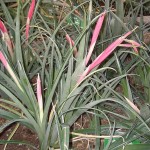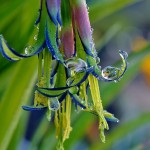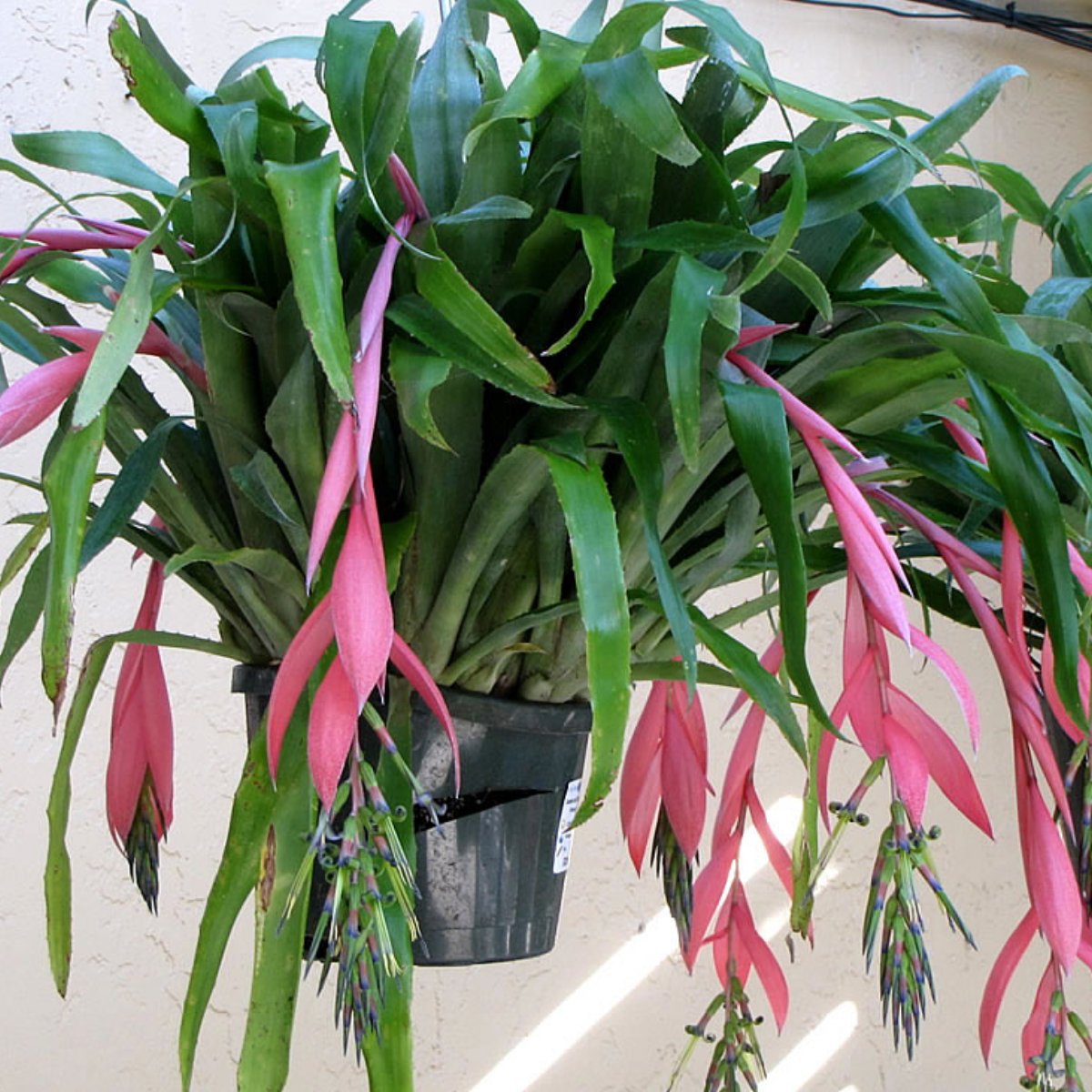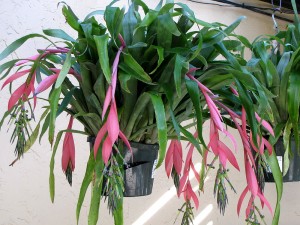Family: Bromeliaceae
Synonymous: Billbergia nutans var. nutans
Billbergia nutans f. rupestris
Billbergia nutans var. schimperiana
Billbergia nutans var. striata
Distribution and habitat: Billbergia nutans is an epiphytic bromeliad native to Brazil, Paraguay, Uruguay, and Argentina. It is often found growing on tree branches in the South American rainforests. They have small roots, mainly used for anchoring themselves on trees, so these tree-dwelling plants gather moisture and nutrients through their leaves.
Description: Billbergia nutans is the most popular of all bromeliads. Young plants grow into upright rosettes. As the leaves age, they arch outward. They usually have only five to eight narrow stiff sward-shaped leaves arranged in a tube shaped rosette of which the upper half flares outward. Its arching leaves are 25-35cm (10-14 inch) long and about 1cm (0.4 inch) wide, leading to a graceful appearance which require some room to spread out. Their olive green colour may become reddish if the plant is grown in full sunlight. The 2cm (0.8 inch) long pendant flowers have pink, blue edged petals and they are backed with 5-8cm (2-3 inch) long pink bracts with papery-looking.
The flowers appear only when the plant reaches its maturity, usually in 2-3 years. They will live for no more than a week or two. There is no regular flowering season for Billbergia nutans, which they may bloom at any time of year. Nor do they have an annual rest period.
Billbergia nutans gets one of its common names, Queen's Tears, from the drops of nectar that weep from the flowers when the plant is moved or touched. Because Billbergia nutans readily produces offsets that can be shared with friends, it is also commonly known as Friendship Plant.
Houseplant care: Billbergia nutans plant is often used as an ornamental plant and it is the easiest to grow and most adaptable bromeliads for indoor use. Given an adequate amount of warmth, they will usually grow continuously.
Light: Bright light with at least three or four hours of direct sunlight every day is essential for good leaf colour and regular flowering.
Temperature: Billbergia nutans grow well in normal room temperatures. Varieties of this species can also tolerate quite cold temperature - down to about 7C (45F). In the summer, this particular plant enjoys warm temperatures outdoors between 18 to 27C (64-81F).
These plants will thrive in moderate humidity, but still benefit from being kept in a spot where they can be misted often to increase humidity.
Watering: Throughout the year, water moderately, enough to make the potting mixture thoroughly moist, but allow the top centimetre (0.4 inch) or so of the potting mixture to dry out between watering.
Water the center of the rosette and keep room-temperature rainwater or naturally soft water in its urn (centre of the rosette) at all times. Empty old water from the urn once a month by turning plants upside down and refill it with fresh water. Do not soak base of plant, which can lead to root rot.
Feeding: Apply standard liquid fertiliser regularly, about every two weeks. Let the liquid not only to penetrate the potting mixture, but splash over leaves and lodge in central cups. Alternatively can be used a foliar fertiliser and spray it on the leaves.
Potting and repotting: Billbergia nutans are the least demanding of bromeliads where potting mixture is concerned; they grow well in either the standard bromeliad mixture or in an equal-parts combination of soil based mixture and leaf mould. Because their roots are not extensive, they can be accommodated in relatively small pots. A 13cm (5 inch) pot will allow several rosettes producing several flowers heads to develop, but Billbergia nutans looks often best when is grown as single specimen with its tall tubular shape. It is best to plant these plants in heavy clay pots rather than plastic ones, to avoid the possibility of their being knocked over. Young plants should be moved into pots one size larger in early spring when it appears necessary.
Gardening: In southern areas it will live in the garden or decorate a patio or terrace and bloom for long periods with very little attention. Divide the clumps every few years. Give them a spray of water every so often in summer if it is dry. This bromeliad is hardy down to freezing temperatures, but prolonged exposure to low temperatures will affect the blooming season.
Position: During summer, provide partial shade to Billbergia nutans plants. At other times of the year, bright but indirect light is required for the health of this plant.
Full summer sunlight can destroy the flowers.
Soil: Being epiphytic, Billbergia nutans can be grown in the fork of a tree, where the cascading flowers can be well displayed, but can also be grown in the ground or in a pot. Like most bromeliads, it will survive in dry, shaded garden beds. The soil should be well drained and can consist from one part gardening soil to two parts perlite or tree bark mixture. Use bromeliad mix or orchid potting mixture for potted plants.
Irrigation: Billbergia nutans gathers most of its moisture from the air through the leaves and flowers. During the summer months, the leaves, flowers, and roots should be watered daily to keep them moist, but never soggy. Any flower cups pointing upward should be filled with water. Keep the center of the plant filled with water but allow the soil to dry out between each wetting. During the fall, winter, and cooler parts of spring, the plant should be misted every few days and watered enough to keep the soil just shy of dry.
Fertilizer: During the summer months, offer this plant a balanced fertilizer once every other week. Flower cups can be filled with the fertilised liquid, and the leaves misted, as well as the soil watered. During other times of the year, reduce fertilisation to once a month.
Propagation: Propagate in spring by means of offsets, but do not remove them until they are 10-15cm (4-6 inch) long and began to assume the characteristics of the parent plant. Very young offsets rarely root successfully. Plant offsets shallowly, retaining any roots that may already have developed, in small pots of bromeliad mixture and place them in medium light. It may be necessary to insert a thin stake as support for an offset until it develops enough roots to anchor it down. Make the potting mixture barely moist, allowing the top 2-5cm (0.8-2 inch) of the mixture to dry out between waterings. Firm rooting is likely to occur in eight weeks. Thereafter, treat the new Billbergia nutans plants exactly the same way as mature plants.
Problem: Billbergia nutans plants tend not to attract diseases and they never need pruning.
If mature Billbergia nutans do not produce blooms can be because the plant is not getting enough light.
Treatment: Move the plant to a brighter location. This plant can be moved outdoors for the summer to a partially shaded spot. Encourage bromeliads to flower by adding a pinch of Epsom salts (magnesium sulfate) to the water or fertilizer.
Additionally, place a ripe apple or a few apple cores around the plant and enclose the whole thing in a clear plastic bag for a week or two. Ripening apples produce ethylene gas that encourages flower buds to form. Keep the plant out of direct sun while it is covered with plastic to prevent it from getting too hot.
Brown tips on leaves are caused by dry air.
Treatment: Although billbergias are more tolerant of dry air than other bromeliads, they benefit from frequent misting with water to increase the humidity.
Uses and display: Billbergia nutans plant is suitable for growing indoors or as epiphytic bromedliad in a conservatory. In warmer climates, the Billbergia nutans can be grown outdoors in well-drained soil or in pots on a terrace or patio or can be anchored in the fork of a tree, replicating its natural habitat. To look at its best, grow these plants in a hanging basket or suspended pot at eye level, where arching leaves and pendant flowers can be seen up close.
SUMMARY:
CHARACTERISTICS:
Foliage variegated
Features flowers
Shape rosette
Height: 45-60cm (18-24 inch)
PROPER CARE:
Watering in active growth period moderately
Light bright
Temperature in active growth period min 7C max 24C (45-75F)
Humidity low
Hardiness zone: 10a-11






